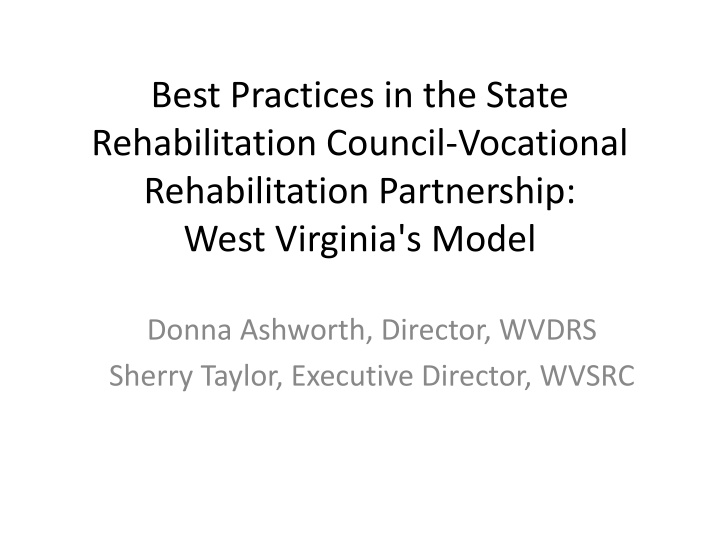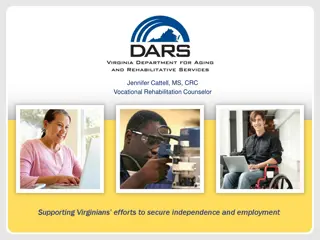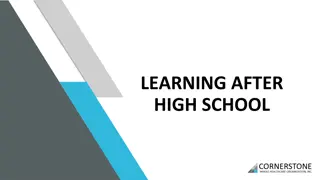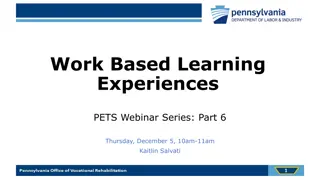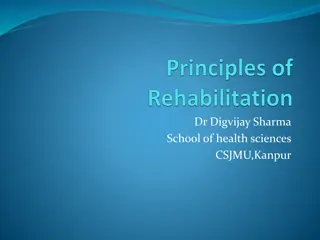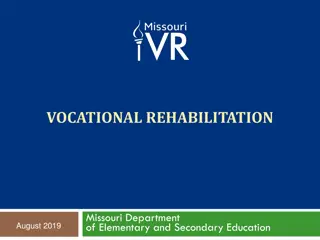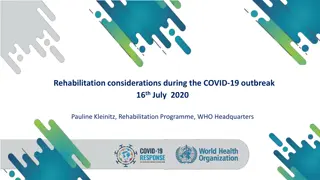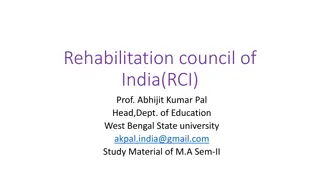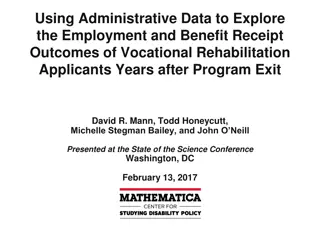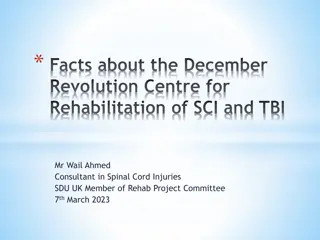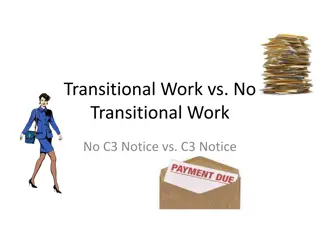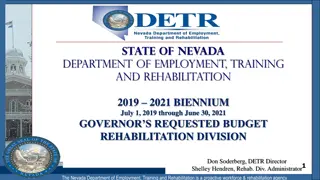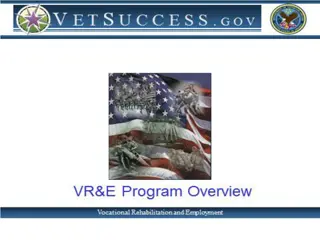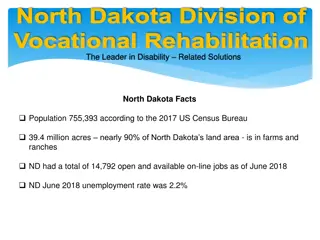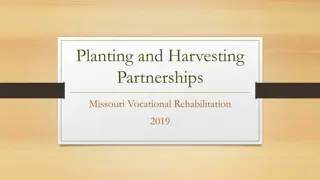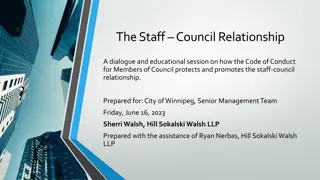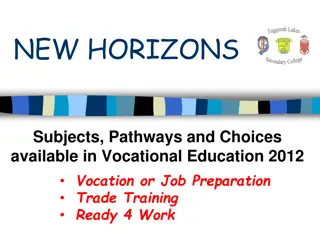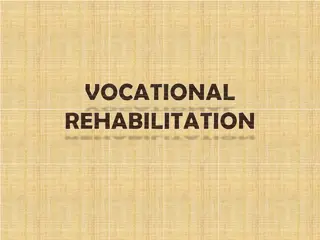State Rehabilitation Council-Vocational Rehabilitation Partnership in West Virginia
The partnership between the State Rehabilitation Council (SRC) and Vocational Rehabilitation (VR) in West Virginia is a model of best practices. Mandated by federal law, this collaboration extends beyond tasks to advocate for individuals with disabilities. The SRC composition includes various stakeholders, and its functions involve advising the state unit, setting goals, evaluating program effectiveness, and more.
Uploaded on Feb 15, 2025 | 0 Views
Download Presentation

Please find below an Image/Link to download the presentation.
The content on the website is provided AS IS for your information and personal use only. It may not be sold, licensed, or shared on other websites without obtaining consent from the author.If you encounter any issues during the download, it is possible that the publisher has removed the file from their server.
You are allowed to download the files provided on this website for personal or commercial use, subject to the condition that they are used lawfully. All files are the property of their respective owners.
The content on the website is provided AS IS for your information and personal use only. It may not be sold, licensed, or shared on other websites without obtaining consent from the author.
E N D
Presentation Transcript
Best Practices in the State Rehabilitation Council-Vocational Rehabilitation Partnership: West Virginia's Model Donna Ashworth, Director, WVDRS Sherry Taylor, Executive Director, WVSRC
Partnership Defined1 Partnership refers to a business or organization where two or more individuals share equal responsibility for the management of profits and losses. Cooperative relationship between people or groups who agree to share responsibility for achieving some specific goal or as a contract between two or more persons who agree to pool talent and money and share profits and losses. WordNet Project, Department of Computer Science, Princeton University 1 McGuire-Kuletz, M., Tomlinson, P., & Siblo, M. (2010). The State Rehabilitation Council vocational rehabilitation partnership: Working together works (Institute on Rehabilitation Issues Monograph No. 36). Washington, DC: The George Washington University, Technical Assistance and Continuing Education Center. 2
Workforce Innovation and Opportunity Act (WIOA) Section 105 of the Rehabilitation Act, as amended by Section 415 of WIOA, mandates the SRC and defines its composition and functions. Though mandated by federal law, the partnership between SRCs and VR extends beyond the shared accomplishment of mandated tasks. It is a call to action to advocate for and to hear the voices of those served by State-Federal VR programs. The partnership must be a commitment and priority for the partners in order to make the VR system an agent of change for people with disabilities to achieve competitive integrated employment! 3
SRC Composition2 Statewide Independent Living Council (SILC) Parent Training and Information Center, pursuant to the Individuals with Disabilities Education Act (IDEA) Client Assistance Program VR Counselor CRP representative Four representatives of business, industry, and labor Disability advocacy groups VR applicants or consumers American Indian Vocational Rehabilitation Services (In States in which one or more projects are funded under section 741) State educational agency responsible for public education of students with disabilities State workforce development board 2 per Rehabilitation Act 725(b)(1)(A), as amended by WIOA 4
SRC Functions3 Review, analyze, and advise the designated State unit regarding the performance of the responsibilities of the unit Develop, agree to, and review State goals and priorities Evaluate the effectiveness of the vocational rehabilitation program and submit reports of progress to the Rehabilitation Services Administration (RSA) Advise the designated State agency and the designated State unit regarding activities, including needs assessment activities Assist in the preparation of the State plan Conduct a review and analysis of the effectiveness of and consumer satisfaction with the VR program Prepare and submit an annual report to the Governor and the Commissioner on the status of vocational rehabilitation programs operated within the State Coordinate activities with the activities of other councils within the State Provide for coordination and the establishment of working relationships between the designated State agency and the Statewide Independent Living Council and centers for independent living within the State 3 per Rehabilitation Act 725(c), as amended by WIOA 5
WVSRC Composition Twenty-six total members (WIOA mandate is 15, plus 1 ex officio) Executive Director, shares office space with WVDRS Serves on WVDRS Executive Management Group Member-appointed Executive Committee Chairperson Vice-Chairperson Secretary Treasurer Past Chairperson Six meetings per year (WIOA mandate is four), open to the public Two-day meeting once a year held jointly with SILC Meetings follow Robert s Rules of Order In addition to the assigned VR counselor and an agency liaison for the SRC, the WVDRS Director, Program Evaluation staff, and others regularly attend scheduled meetings 6
WVSRC Committees Executive Committee Membership Committee Nominating Committee Consumer Satisfaction Survey Committee Annual Report Committee State Plan Committee Bylaws Committee SRC/WVDRS Partnering Committee Assures that communication and partnership remains at the highest possible level. The committee meets with the WVDRS Director and other designated VR staff to review the agency s position, financial status, policies, and any issues that the SRC may offer assistance and support. 7
WVSRC Goals and Objectives4 Comply with the functions of the Council as stated in the Rehabilitation Act as amended by WIOA; Continue strong partnership with WVDRS management staff and personnel acting as an advocate, confidant, and agency ambassador; Receive regular updates from WVDRS Director on efforts to increase public awareness; Council shall be educated and knowledgeable about services and programs within WVDRS; Be an active member of the WVDRS Policy Consultation Group; Maintain an active role in the National Coalition of the State Rehabilitation Council (NCSRC) participating on the national steering committee, attending state and national conferences to bring the information gained to the enrichment of the Council; Participate in the Council of State Administrators of Vocational Rehabilitation (CSAVR); Have independently prepared report provided electronically and verbally to Council members and designated VR staff; Conduct combined public forums with WVDRS and the WV Statewide Independent Living Council (SILC) to educate the general public about WVDRS and the role(s) of the Council(s); Encourage Council members to become an active member of their local Consumer Affairs Committee (CAC); and Use social media to link the SRC to other partners giving access on the internet to the Annual Report, website and during public awareness events. 8 4 From WVSRC 2013-2014 Annual Report
Continuous Recruitment Proactive Multi-faceted Outreach to targeted populations Educate potential WVSRC members Role and responsibilities of WVSRC Expectation of the individual WVSRC members Relationship with Governor to ensure timely appointments and approvals 9
WVDRS Support and Sponsorship WVSRC is funded by WVDRS to fulfill its responsibilities as mandated by WIOA. Allows the WVSRC to host regularly scheduled meetings in order to make decisions, and share information with WVDRS and other attendees Covers cost of travel for WVSRC members to attend regularly scheduled meetings in order to promote attendance and establish quorums Allows WVSRC members to attend national conferences in order to stay abreast of trends and issues facing individuals with disabilities 10
Human and Fiscal Resources WVSRC Executive Director and members must fully commit the necessary time and effort into their duties/responsibilities. WVSRC Executive Director has an office at WVDRS State Administrative Office location. WVDRS provides meeting room access for WVSRC meetings. WVSRC has access to WVDRS administrative personnel for information and technical assistance. 11
WVDRS-WVSRC Joint Activities WVSRC is represented/participates in WVDRS Executive Management Group meetings once a month. Consumer satisfaction survey WVDRS provides necessary consumer information to the WVSRC. WVDRS responds to results of the annual consumer satisfaction survey reports (overall and transitioning youth). Comprehensive Statewide Needs Assessment (CSNA) activities Strategic Planning State Plan development Goals and Priorities WVSRC Input 12
Necessary Conditions Certain conditions must exist to allow a mutually beneficial working relationship Open door policy between VR and SRC Aim to work together to better serve individuals with disabilities Respond promptly to SRC questions, concerns, and recommendations Regular data sharing between VR and SRC 13
Data Sharing WVSRCs Role State of the WVSRC/Budget Recent and upcoming WVSRC activities 14
Data Sharing WVDRS Directors Role State of the VR Agency Recent activities of the Agency Provide responses to questions posed to the agency during meetings 15
Data Sharing Program Evaluation Activities Progress on Goals and Priorities CSNA activities and ongoing results Continue to report on RSA Evaluation Standards and Performance Indicators Standard 1 Assesses VR s Impact on Employment Standard 2 Assesses Equal Access Opportunity for Individuals of all Groups and Backgrounds Report on the new Common Measures 16
RSA Evaluation Standards and Performance Indicators for the VR Program Performance Indicator Description 1.1: Change in Employment Outcomes Number of employment outcomes compared to previous year 1.2: Percent of Employment Outcomes Percent of individuals with employment outcomes after receiving services 1.3: Competitive Employment Outcomes Primary Indicator Percentage of successful rehabilitants in competitive employment 1.4: Significance of Disability Primary Indicator Percentage of individuals identified in 1.3 who have significant disabilities 1.5: Earnings Ratio Primary Indicator Ratio of avg. hourly earnings of individuals identified in 1.3 to that of all employed individuals in the State 1.6: Self-Support Difference in percentage of individuals identified in 1.3 reporting their income as their largest source of support at entry vs. exit 2.1: Minority Background Service Rate Ratio of the percent of individuals with a minority background to the percent of individuals without a minority background exiting the program who received VR services 17
WIOA Primary Indicators of Performance Performance Indicator Formula Number of Exiters [Status 26, 28, and 30 (from Status 12)] in unsubsidized employment during 2nd quarter after exit The percentage of participants who are in unsubsidized employment during the second quarter after exit from the program Total Number of Exiters Number of Exiters [Status 26, 28, and 30 (from Status 12)] in unsubsidized employment during 2nd quarter after exit The percentage of participants, who are in unsubsidized employment during the fourth quarter after exit from the program Total Number of Exiters The 50th percentile of earnings of participants during the second quarter after exit from the program Median earnings of participants, who are in unsubsidized employment during the second quarter after exit from the program 18
WIOA Primary Indicators of Performance Performance Indicator Formula The percentage of participants who obtained a recognized post-secondary credential or a secondary school diploma, or its recognized equivalent during participation in or within 1 year after exit from the program. A participant who has obtained a secondary school diploma or its recognized equivalent is only included in this measure if the participant is also employed or is enrolled in an education or training program leading to a recognized post-secondary credential within 1 year from program exit (Number of Participants who obtained a recognized postsecondary credential during participation or within 1 year of exit) plus (Number of participants who obtained a Secondary School Diploma or equivalent during participation in or within 1 year of exit and are either employed or enrolled in a program leading to a recognized post-secondary credential within 1 year of exit) Total Number of Participants The percentage of participants who during a program year (July 1 June 30), are in an education or training program that leads to a recognized post-secondary credential or employment and who are achieving measurable skill gains, defined as documented academic, technical, occupational or other forms of progress, towards such a credential or employment. Number of Participants in an education or training program that leads to a recognized post-secondary credential or employment and are achieving measurable skill gains Total Number of Participants Effectiveness in serving employers, based on indicators developed as required by sec. 116(b)(2)(A)(iv) of WIOA. To be determined 19
